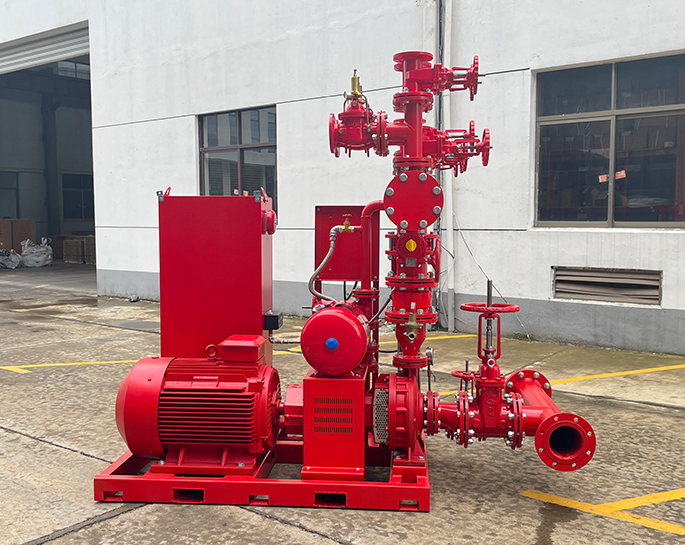Precautions before starting the fire water pump
Nov 28, 2023
Share:
Starting a fire water pump is an important task that requires careful attention to safety. Here are some precautions to consider before starting a fire water pump:
Ensure Proper Training:
Only trained personnel should operate the fire water pump. Make sure that the individuals responsible for starting and operating the pump have received adequate training in its use.
Inspect Equipment:
Regularly inspect the fire water pump and associated equipment to ensure that everything is in proper working order. This includes checking for leaks, loose connections, and any signs of damage.
Verify Power Source:
If the pump is powered by electricity, ensure that the power source is stable and reliable. Check the power supply, connections, and any electrical components for signs of wear or damage.
Fuel Check (for Engine-Driven Pumps):
If the fire water pump is driven by an engine, ensure that there is sufficient fuel. Check the fuel level, and if necessary, refuel according to the manufacturer's guidelines.
Proper Priming:
Fire water pumps often need to be primed before operation to remove air from the system and ensure proper water flow. Follow the manufacturer's instructions for priming the pump correctly.
Open Water Supply Valve:
Ensure that the water supply valve is open to allow water to flow into the pump. This is crucial for the pump to function effectively.
Check Water Discharge Points:
Verify that all the water discharge points, such as hoses and nozzles, are properly connected and in good condition. Make sure they are clear of any obstructions.
Emergency Stop Procedures:
Familiarize yourself with the emergency stop procedures. In case of any issues or emergencies, knowing how to quickly and safely shut down the pump is essential.
Clear the Area:
Ensure that the area around the fire water pump is clear of any obstacles or debris. This helps prevent accidents and allows for easy access to the pump.
Communication:
Establish a means of communication with other team members or relevant authorities to coordinate pump operation effectively.
Protective Gear:
Wear appropriate personal protective equipment (PPE), such as gloves and eye protection, to ensure personal safety during the operation.
Follow Local Regulations:
Adhere to local regulations and guidelines related to the operation of fire water pumps. This includes compliance with safety standards and environmental regulations.
Always refer to the manufacturer's guidelines and specific equipment manuals for detailed instructions on the operation and maintenance of the fire water pump you are using. Additionally, consider conducting regular drills or training exercises to ensure that personnel are familiar with the proper procedures.

Ensure Proper Training:
Only trained personnel should operate the fire water pump. Make sure that the individuals responsible for starting and operating the pump have received adequate training in its use.
Inspect Equipment:
Regularly inspect the fire water pump and associated equipment to ensure that everything is in proper working order. This includes checking for leaks, loose connections, and any signs of damage.
Verify Power Source:
If the pump is powered by electricity, ensure that the power source is stable and reliable. Check the power supply, connections, and any electrical components for signs of wear or damage.
Fuel Check (for Engine-Driven Pumps):
If the fire water pump is driven by an engine, ensure that there is sufficient fuel. Check the fuel level, and if necessary, refuel according to the manufacturer's guidelines.
Proper Priming:
Fire water pumps often need to be primed before operation to remove air from the system and ensure proper water flow. Follow the manufacturer's instructions for priming the pump correctly.
Open Water Supply Valve:
Ensure that the water supply valve is open to allow water to flow into the pump. This is crucial for the pump to function effectively.
Check Water Discharge Points:
Verify that all the water discharge points, such as hoses and nozzles, are properly connected and in good condition. Make sure they are clear of any obstructions.
Emergency Stop Procedures:
Familiarize yourself with the emergency stop procedures. In case of any issues or emergencies, knowing how to quickly and safely shut down the pump is essential.
Clear the Area:
Ensure that the area around the fire water pump is clear of any obstacles or debris. This helps prevent accidents and allows for easy access to the pump.
Communication:
Establish a means of communication with other team members or relevant authorities to coordinate pump operation effectively.
Protective Gear:
Wear appropriate personal protective equipment (PPE), such as gloves and eye protection, to ensure personal safety during the operation.
Follow Local Regulations:
Adhere to local regulations and guidelines related to the operation of fire water pumps. This includes compliance with safety standards and environmental regulations.
Always refer to the manufacturer's guidelines and specific equipment manuals for detailed instructions on the operation and maintenance of the fire water pump you are using. Additionally, consider conducting regular drills or training exercises to ensure that personnel are familiar with the proper procedures.







